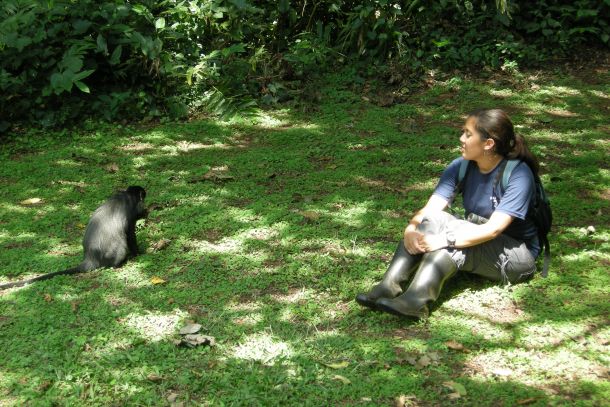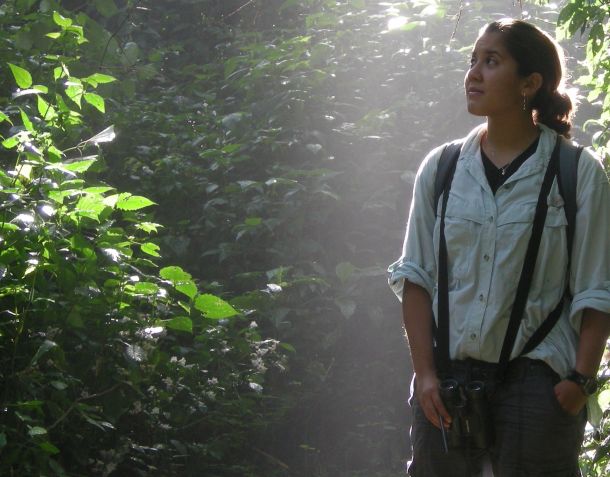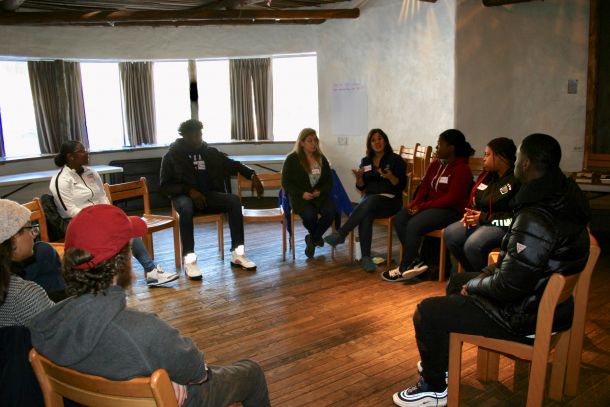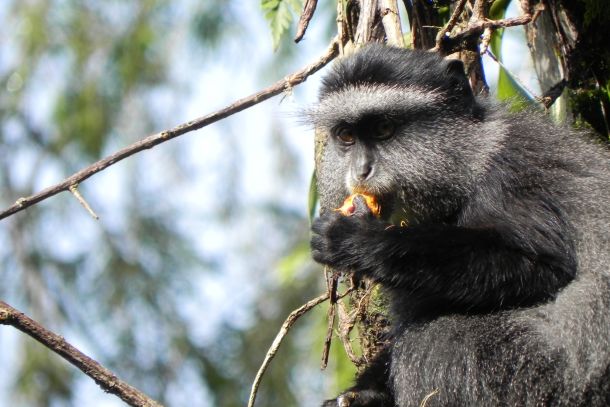This piece comes to us from the Wildlife Conservation Society (WCS). To honor Asian and Pacific Islander Heritage Month, WCS and Nature are sharing stories of nature and conservation.

Su-Jen in front of the Bronx Zoo’s Zoo Center building. Su-Jen is primarily based at the Bronx Zoo, but supports all five WCS parks with their evaluation needs. Photo credit: Shuli Rank/WCS.
Walking around our parks is an important reminder for me of how zoos and aquariums are welcoming places for people to fall in love with animals and nature. I love seeing visitors of all ages and backgrounds marvel at a close-up view of a gorilla, feed a goat, or imitate a flamingo, and think that this is some of the best evidence that zoos and aquariums are places for lifelong learning and connection.
I oversee the Educational Research and Evaluation team at WCS’s zoos and aquarium. We use social science research methods to document the impact of WCS’s work to inspire people to save wildlife and wild places. Data we collect through surveys, observations, and interviews provide insight into what students learn in education programs, how visitors connect with our animals, and how youth volunteers develop as science communicators.

Su-Jen relaxing while watching Gaunt the blue monkey, matriarch of a favorite Kakamega monkey family. Photo courtesy of Sue-Jen Roberts.
Prior to joining WCS, I was a primate researcher, traveling between New York City and Kakamega Forest, a rainforest in western Kenya and home to a population of blue monkeys that have been studied since the 1970s. At the time, Kakamega Forest was remote. It was a destination for only the most avid birders who would travel there to see the Great Blue Turaco and hundreds of other forest-dwelling species, some of which cannot be found anywhere else in the wild.
While in Kakamega, I studied a population of about 200 blue monkeys, each of whom I came to recognize individually, sometimes when they were 80 feet up in a tree! Blue monkeys are gregarious and the Kakamega blues are particularly so, living in groups of up to 50 mothers, sisters, aunts, and babies, and a single resident male.

Su-Jen searching for blue monkeys in Kakamega Forest, Kenya’s only tropical rainforest. Photo credit: ©James Fuller.
Despite the species’ high level of sociality, studying them in the field was lonely work that made me acutely aware of my position as an outsider. I was American, a woman, and Asian, a combination that could be challenging as I navigated the bureaucracy to secure my research permits and ensure my safety in the field. I began seeking out opportunities to collaborate with others who were also working to understand and protect wild animals and their habitats.
Conservation is an applied field and part of my journey has been learning to bridge theory and practice to ensure that conservation professionals are using research-based approaches to do their work better. Today, I study people rather than monkeys, and that application comes through supporting WCS in fostering stronger connections with our zoo and aquarium audiences.
For example, we recently studied techniques to improve visitors’ positive perceptions of scientists through exhibit signage and live interpretation. We know that visitors have a wide range of science identities and this research identified message framing techniques that are most effective for science skeptics versus science enthusiasts (spoiler: they’re not the same).
Studying science identity creates space for reflection on how other facets of identity, including race, affect how humans interact with the world. My identity as a mixed-race person (my mom is Asian and my dad is white) has shaped my personal and professional life. I’ve never quite felt like I “fit in” when race is discussed – I can fit in partially as white or Asian, but not fully as either.

Su-Jen runs a focus group with members of the Bronx Zoo’s Youth Employee Advisory Council. Photo credit: Emily Stoeth/WCS.
I sometimes encounter the unnerving experience of someone puzzling—quietly or overtly—over which category to put me in. These experiences have attuned me to the tension between the importance of race in our society and the inadequacy of racial categories to capture human diversity. In my role as a survey designer, I always write demographic questions that allow respondents to “select all that apply” or self-describe!
One way that I’m fortunate to contribute to WCS’s work on diversity, equity, and inclusion (DEI) is through the WCS Career Lattice, our integrated career pathways program through which New York City youth have expanded entry points to opportunities at our parks. WCS youth volunteers, interns, and part-time employees are some of our greatest assets. They reflect the demographic diversity of our city and their perspectives and voices are critical for advancing our mission. Our youth development research spans a variety of topics.
We’ve studied the relative impact of mentoring and hands-on research on youths’ STEM academic trajectories and are currently collecting data to understand how inclusive recruiting and support practices can expand access to the critical real-world experience that young people gain through WCS internships.

A juvenile blue monkey eating palm fruit. Fruit is a favorite part of the blue monkey diet and knowledge of fruiting trees often helped the research team find the monkeys. Photo credit: ©Su-Jen Roberts.
Another meaningful initiative for me involves leading the measurement efforts to understand WCS’s progress towards our DEI goals. This includes conducting employee surveys and tracking a variety of demographic metrics to understand how our DEI program is contributing to a more inclusive WCS. This project allows me to work across departments, providing the collaboration and connection that are so important to my practice and the success of DEI work generally.
In a remote Kenyan forest studying primate social networks, I fell in love with wildlife and wild places. I am privileged to help spread that love of nature, supporting WCS in inspiring visitors, students, volunteers, interns, and staff to connect ever more deeply with our mission.
